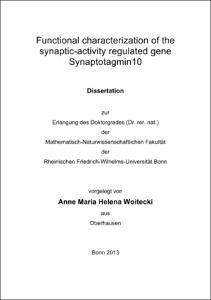Woitecki, Anne Maria Helena: Functional characterization of the synaptic-activity regulated gene Synaptotagmin10. - Bonn, 2013. - Dissertation, Rheinische Friedrich-Wilhelms-Universität Bonn.
Online-Ausgabe in bonndoc: https://nbn-resolving.org/urn:nbn:de:hbz:5n-34312
Online-Ausgabe in bonndoc: https://nbn-resolving.org/urn:nbn:de:hbz:5n-34312
@phdthesis{handle:20.500.11811/5802,
urn: https://nbn-resolving.org/urn:nbn:de:hbz:5n-34312,
author = {{Anne Maria Helena Woitecki}},
title = {Functional characterization of the synaptic-activity regulated gene Synaptotagmin10},
school = {Rheinische Friedrich-Wilhelms-Universität Bonn},
year = 2013,
month = dec,
note = {During epileptogenesis multiple cellular and molecular changes occur in the brain resulting in the emergence of recurrent spontaneous seizures. One member of the Synaptotagmin (Syt) gene family that is rapidly and transiently up-regulated in the rat hippocampus early after the experimental induction of SE but is barely detectable in the native brain is Syt10. However, the knowledge about the function of Syt10 in health and disease conditions, especially in the hippocampus, is very limited.
In order to delineate the mechanisms regulating Syt10 gene expression in response to strong electrical stimulation, this study provided the first fundamental bioinformatic and functional characterization of the Syt10 promoter and genomic regulatory regions in different cell types. Conserved regions in the Syt10 gene mediated strong induction of Syt10 promoter activity, particularly in the hippocampal formation. The transcription factor NPAS4 was identified to positively regulate endogenous expression of Syt10 as well as, together with Per1, Syt10 promoter activity. Epilepsy-induced up-regulation of endogenous Syt10 expression was mimicked and a key genomic region underlying depolarization-mediated induction of the Syt10 promoter was clearly identified.
As a way to obtain first insights into the putative function of Syt10, its subcellular distribution was examined in hippocampal neurons and was compared with the related Syt isoforms 3, 5 and 6. Syt10 was identified not to be a resident Golgi protein but partially co-localized with IGF1 and with NPY. These results support the hypothesis that Syt10 is localized to large vesicular structures but not to synaptic vesicles. Furthermore, targeting signals defining the subcellular localization of Syt10 were analyzed.
Additionally, first steps have been accomplished regarding the identification of Syt10 containing protein complexes or organelles forming the basis for an isolation of the respective complexes from the hippocampus following status epilepticus (SE).
To date, the role of Syt10 in epileptogenesis remains enigmatic and the spatiotemporal expression profile was only analyzed in rats. Therefore, the time course of Syt10 expression following pilocarpine-induced SE was examined in mice. The strongest induction of Syt10 expression in mice was observed with a 30 hours delay compared to rats but did not show an exact parallelism to the IGF1 augmentation. However, as reported for IGF1, Syt10 was observed to be important for SE-induced progenitor cell proliferation as well. These data may suggest that Syt10 plays a critical role in the attenuation of acquired changes during epileptogenesis.
Taken together, the results of this thesis provide novel insights into the key mechanisms regulating Syt10 expression in the hippocampus in the normal and epileptic brain as well as into the subcellular distribution of Syt10 and form the basis for further studies into the precise understanding of the function of Syt10 during epileptogenesis.},
url = {https://hdl.handle.net/20.500.11811/5802}
}
urn: https://nbn-resolving.org/urn:nbn:de:hbz:5n-34312,
author = {{Anne Maria Helena Woitecki}},
title = {Functional characterization of the synaptic-activity regulated gene Synaptotagmin10},
school = {Rheinische Friedrich-Wilhelms-Universität Bonn},
year = 2013,
month = dec,
note = {During epileptogenesis multiple cellular and molecular changes occur in the brain resulting in the emergence of recurrent spontaneous seizures. One member of the Synaptotagmin (Syt) gene family that is rapidly and transiently up-regulated in the rat hippocampus early after the experimental induction of SE but is barely detectable in the native brain is Syt10. However, the knowledge about the function of Syt10 in health and disease conditions, especially in the hippocampus, is very limited.
In order to delineate the mechanisms regulating Syt10 gene expression in response to strong electrical stimulation, this study provided the first fundamental bioinformatic and functional characterization of the Syt10 promoter and genomic regulatory regions in different cell types. Conserved regions in the Syt10 gene mediated strong induction of Syt10 promoter activity, particularly in the hippocampal formation. The transcription factor NPAS4 was identified to positively regulate endogenous expression of Syt10 as well as, together with Per1, Syt10 promoter activity. Epilepsy-induced up-regulation of endogenous Syt10 expression was mimicked and a key genomic region underlying depolarization-mediated induction of the Syt10 promoter was clearly identified.
As a way to obtain first insights into the putative function of Syt10, its subcellular distribution was examined in hippocampal neurons and was compared with the related Syt isoforms 3, 5 and 6. Syt10 was identified not to be a resident Golgi protein but partially co-localized with IGF1 and with NPY. These results support the hypothesis that Syt10 is localized to large vesicular structures but not to synaptic vesicles. Furthermore, targeting signals defining the subcellular localization of Syt10 were analyzed.
Additionally, first steps have been accomplished regarding the identification of Syt10 containing protein complexes or organelles forming the basis for an isolation of the respective complexes from the hippocampus following status epilepticus (SE).
To date, the role of Syt10 in epileptogenesis remains enigmatic and the spatiotemporal expression profile was only analyzed in rats. Therefore, the time course of Syt10 expression following pilocarpine-induced SE was examined in mice. The strongest induction of Syt10 expression in mice was observed with a 30 hours delay compared to rats but did not show an exact parallelism to the IGF1 augmentation. However, as reported for IGF1, Syt10 was observed to be important for SE-induced progenitor cell proliferation as well. These data may suggest that Syt10 plays a critical role in the attenuation of acquired changes during epileptogenesis.
Taken together, the results of this thesis provide novel insights into the key mechanisms regulating Syt10 expression in the hippocampus in the normal and epileptic brain as well as into the subcellular distribution of Syt10 and form the basis for further studies into the precise understanding of the function of Syt10 during epileptogenesis.},
url = {https://hdl.handle.net/20.500.11811/5802}
}






